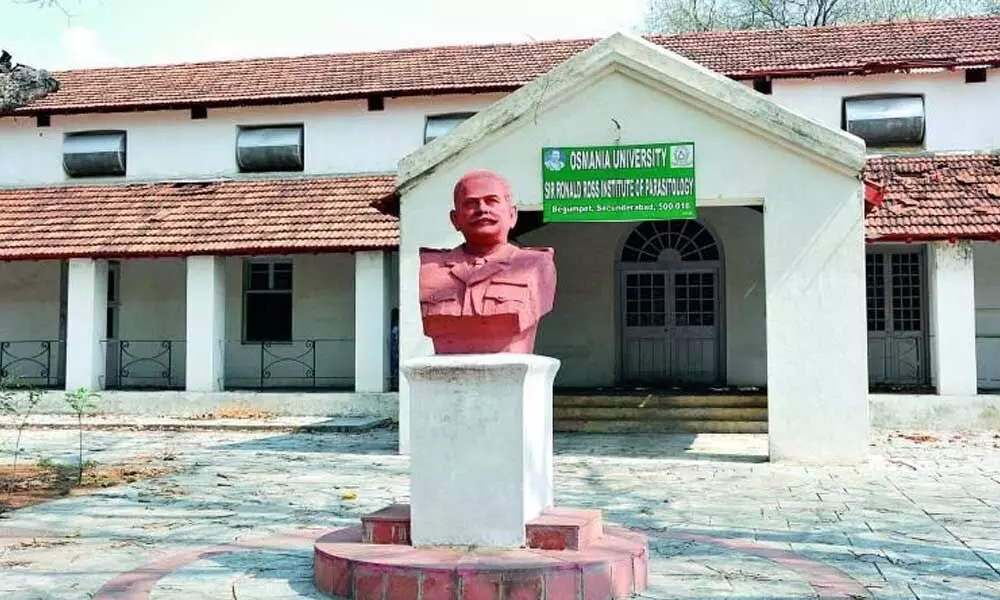Live
- “Telangana Ready to Support AI Technologies That Drive Social Impact,” says Special Chief Secy, Jayesh Ranjan at Woxsen University’s Future Tech Summit 2024
- Hero Motosports Team Rally Announces Squad For Dakar Rally 2025
- Two Men Found Dead In Parked Caravan In Kerala
- Mandhana moves closer to top spot in ODI, T20I rankings
- IND vs AUS Boxing Day Test 2024: Sam Konstas Debuts, Travis Head’s Fitness in Question
- Congress Challenges Election Rule Amendments In Supreme Court
- Jaishankar’s US Visit: Key Diplomatic Engagement Amid Leadership Transition
- Orthodox Church Bishop Criticizes PM Modi’s Christmas Celebration Participation
- Janhvi style & grace takes centre stage
- Allu Arjun’s Pushpa 2 Becomes First Hindi-Dubbed Film to Cross Rs 700 Crore
Just In
Revamp Sir Ronald Ross Institute of Parasitology


Revamp Sir Ronald Ross Institute of Parasitology
Sir Ronald Ross performed pioneering research on malaria which won him the Nobel Prize in 1902
Sir Ronald Ross performed pioneering research on malaria which won him the Nobel Prize in 1902. The Sir Ronald Ross Institute of Parasitology is the heritage building where Sir Ronald Ross discovered the cause and remedy for malaria in 1897. Declared a protected monument by the Archaeological Survey of India, the institute is now under the protection of Osmania University (OU), who acquired it from the then Deccan Airlines in 1955.
Research scholars from Osmania University worked here until the building was taken over by the Airports Authority of India (AAI). A pilot training centre was set up in this building. Former Prime Minister Rajiv Gandhi trained here. In 1979, Osmania University took over the building and continued research here. But now, the building lies deserted.
Nobel laureate Ronald Ross discovered the presence of malarial parasite in the intestines of female anopheles' mosquito at the far end of his stint as medical officer on these premises between 1895 and 1897, when it was a hospital for the British regimental troops. Copy of a journal entry by Mr. Ross about the discovery dated August 20 can be found in the museum, as also his drawings of the parasite.
The building later served as an "officers mess" for British regiment and was under Deccan Airlines for a brief while. Later after accession of Hyderabad State, it was handed over to the Osmania Medical College for further research on Malaria.
However, later, the 2.5-acre premises were handed over to the Airport Authority of India (then National Airports Authority) for development of the peripheral areas of the Begumpet Airport. In 1975, with initiative from the OU Zoology department, the structure was handed over to the Osmania University, while the land remains with the AAI. After being identified as heritage structure, renovation of the building was carried out in 2010-12 with Rs.45 lakh, which has brought back the lost aura to it. However, since then, the premises remain unoccupied, with whatever research in the institute's name, having been shifted out into the OU premises.
Land ownership by the AAI remains a road-block for any effort to develop it as a pioneering research centre for vector-borne diseases. There is no approach road to the premises. Being a heritage building, the Archaeological Survey of India had granted Rs 6.5 crores for its further development, but it could not materialise due to non-demarcation of the abutting land. Osmania University has not given any funds for the development of the historic building and that the buck has been passed on to the state, who is equally uninterested in the welfare of the building.
The pride of being home to the discovery of malarial parasite is not something that any city would let pass without a care. The site of such historic discovery in Hyderabad, however, lies tucked away in a remote corner of Begumpet, unnoticed by many, and unused for more than 10 years.
The Sir Ronald Ross Institute of Parasitology, a heritage building, is under lock and key for most of the time, not open even for the visitors who might be interested in catching a few glimpses of the photo museum inside.
A visit to the institute makes the sad state of affairs abundantly clear. Located right opposite the Central Government Health Scheme Hospital (CGHS), the building still looks majestic despite its fading colours. Surrounded by dense foliage, the building looks just like an abandoned Victorian-era bungalow.
(The author is President, Telangana Pharma Society and Chairman, Lead India Foundation Campaign)
Wishlist
♦ Make it as heritage museum and study (education and scientific) tourism place
♦ Explore potential for making it a major tourist attraction and an inspiration for students as it is here that Sir Ronald Ross made a huge discovery with just a microscope
♦ Provide facilities and appoint a Guide for visitors
♦ Repairs should be carried out
Prevent unruly elements
Protect the great facade

© 2024 Hyderabad Media House Limited/The Hans India. All rights reserved. Powered by hocalwire.com






